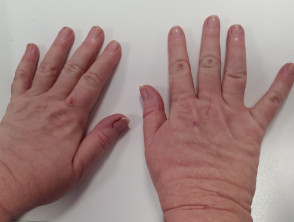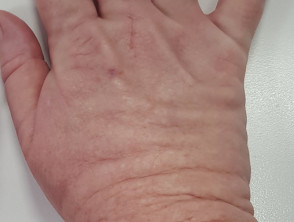What is acral persistent papular mucinosis?
Acral persistent papular mucinosis is a distinct subtype of localised lichen myxoedematosus. It is characterised by discrete papules on the back of the hands, wrists, and forearms. A skin biopsy shows mucin deposition within the dermis [1].
Acral persistent papular mucinosis
Who gets acral persistent papular mucinosis?
Acral persistent papular mucinosis is very rare, with about 30 cases reported in the literature [2].
It occurs most frequently in women, with a ratio of 3:1. The average age of onset is 43 years. The majority of cases have been reported in people of European heritage, but this is thought to be because of increased awareness of acral persistent papular mucinosis in Western countries [2].
Most cases do not appear to have a familial or genetic link, but there is one report of two sisters both being diagnosed with acral persistent papular mucinosis [2].
Four cases have reported a history of malignant tumours; it is unclear whether this association is relevant [2].
What causes acral persistent papular mucinosis?
The cause of acral persistent papular mucinosis is unknown [3].
What are the clinical features of acral persistent papular mucinosis?
Acral persistent papular mucinosis is characterised by:
- Few to multiple, 2–5 mm, ivory or skin-coloured asymptomatic papules
- Lesions located on the backs of the hands, wrists, or forearms
- Persistence and an increase in the number of papules over time [4].
Acral persistent papular mucinosis has no association with gammopathy, thyroid disorders, or other systemic abnormalities.
What are the complications of acral persistent papular mucinosis?
Unlike other forms of lichen myxoedematosus, acral persistent papular mucinosis is a benign disorder and does not affect other organs [4].
How is acral persistent papular mucinosis diagnosed?
Acral persistent papular mucinosis is diagnosed by recognising its clinical and histological features [3].
The histological features of a skin biopsy of acral persistent papular mucinosis are:
- A focal and well-circumscribed lesion
- Mucin deposition in the papillary and mid-dermis without extension to the deep reticular dermis
- A grenz zone in which there is no mucin deposition
- Variable or absent fibroblast proliferation.
Mucin deposition can be highlighted using Alcian blue or colloidal iron stains [3].
What is the differential diagnosis for acral persistent papular mucinosis?
Acral persistent papular mucinosis should be distinguished from other forms of mucinosis, including the other types of localised lichen myxoedematosus. These include:
- Discrete papular lichen myxoedematosus — this is characterised by a few to hundreds of small papules distributed over the limbs and trunk
- Cutaneous papular mucinosis of infancy — this is characterised by multiple small papules on the upper extremities, neck, and trunk of an infant
- Nodular lichen myxoedematosus — this is characterised by numerous nodules on the limbs and trunk and does not have a papular component [4].
Acral persistent papular mucinosis should also be distinguished from widespread mucinoses such as scleromyxoedema, in which there are widespread papules 2–3 mm in size and arranged linearly. These papules often appear on the head, neck, trunk, hands, forearms, and thighs. Scleromyxoedema is almost always associated with gammopathy [4].
Papules on the hands and forearms can be due to many disorders, such as:
- Granuloma annulare
- Molluscum contagiosum
- Acrokeratoelastoidosis, including:
- Keratoelastoidosis marginalis of the hands
- Degenerative collagenous plaques of the hand [2].
What is the treatment for acral persistent papular mucinosis?
Several treatments for acral persistent papular mucinosis have been reported, but these have generally been unsuccessful. These include:
- Topical and intralesional corticosteroids [2]
- Electrocoagulation [2].
What is the outcome for acral persistent papular mucinosis?
As the name suggests, acral persistent papular mucinosis does not resolve spontaneously [1].

